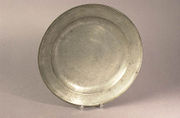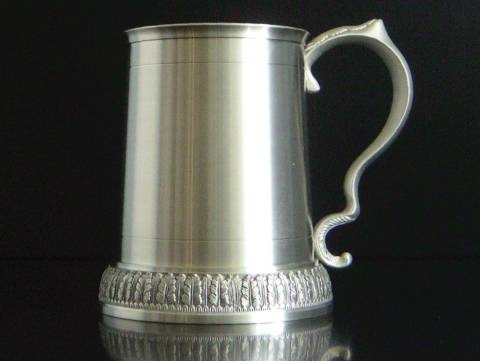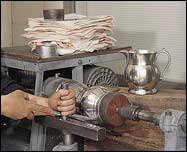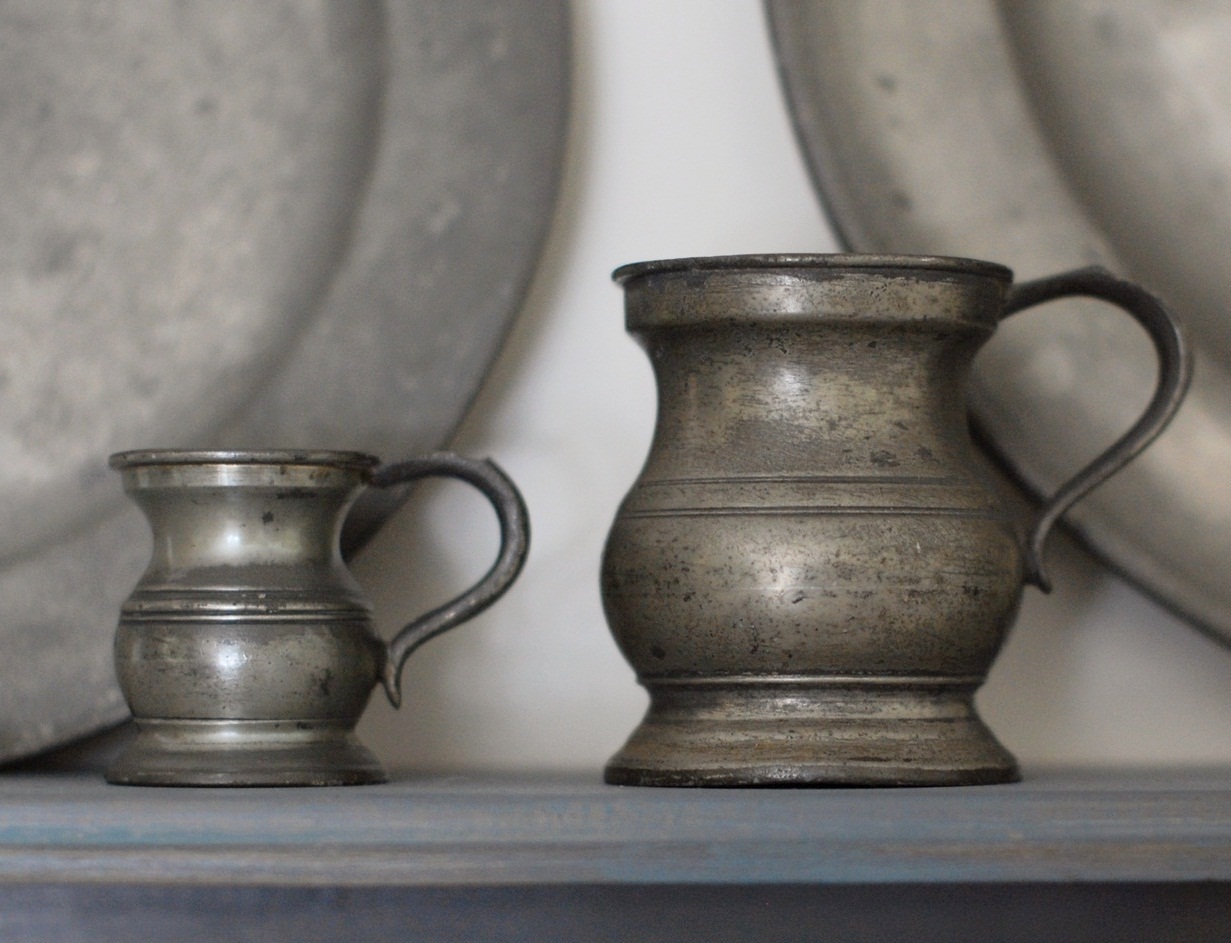Pewter is a metal alloy, traditionally between 85 and 99 % tin, with the remainder consisting of 1-4 % copper, acting as a hardener, with the addition of lead for the lower grades of pewter and a bluish tint. There were three grades: Fine, for eatingware, with 96-99 % tin, and 1-4 % copper; Trifle, also for eating and drinking utensils but duller in appearance, with 92 % tin, 1-4 % copper, and up to 4 % lead; and Lay or Ley metal, not for eating or drinking utensils, which could contain up to 15 % lead. Modern pewter mixes the tin with copper, antimony and/or bismuth, as opposed to lead. Bismuth and zinc can also be added to pewter. Pewter cannot be used to make tools.
 Physically, pewter is a bright, shiny metal that is very similar in appearance to silver. Like silver, pewter will also oxidize to a dull gray over time if left untreated. Pewter is a very malleable alloy, being soft enough to carve with hand tools, and it also takes good impressions from punches or presses. Some types of pewter pieces, such as candlesticks, would be turned on a metal lathe. Pewter has a low melting point, and duplication by casting will give excellent results.
Physically, pewter is a bright, shiny metal that is very similar in appearance to silver. Like silver, pewter will also oxidize to a dull gray over time if left untreated. Pewter is a very malleable alloy, being soft enough to carve with hand tools, and it also takes good impressions from punches or presses. Some types of pewter pieces, such as candlesticks, would be turned on a metal lathe. Pewter has a low melting point, and duplication by casting will give excellent results.
Pewter is essentially tin but to be worked it has to be mixed with other metals. In past centuries there were laid down strict specifications for the alloy and up to the end of the eighteenth century pewter manufacture throughout England was monitored.
The alloy used today in pieces which display the quality touchmarks of the Association of British Pewter
Craftsmen is in the range:
- tin 91-5% minimum,
- antimony 8% maximum,
- copper 2.5% maximum
- bismuth 0-5% maximum,
as determined by the European Standard for pewter. Modern pewter contains no lead.
Pewter may be fashioned in many ways:
- by casting in moulds of bellmetal, steel or sand, using gravity method,
- by centrifugal casting, using rubber or silicone moulds,
- by spinning, on a lathe,
- by pressing, rolling or hand forming.
The surface may be polished or darkened, engraved, etched or hammered. It may also be painted, enamelled or decorated. If the artefact is unsatisfactory, the metal can be melted down (at about 250C) and reused without loss of quality.
Tin, the major constituent of pewter, is produced from tin ore, the major source of supply being the Far East and South America. Tin is completely non-toxic, melts at a relatively low temperature (232C), has very good fluidity when molten, has good formability, and readily forms alloys with other metals. It is a relatively soft metal and it is for this reason that it is alloyed with other constituents before being used in the form of pewter.
Use of pewter was common from the Middle Ages up until the various developments in glass-making during the 18th and 19th centuries. Pewter was the chief tableware until the making of china. Mass production of glass products has seen glass universally replace pewter in day-to-day life. Pewter artifacts continue to be produced, mainly as decorative or specialty items. Pewter was also used around East Asia. Roman pewter items are very rare, although some are still in existence. Pewter gradually stopped being used and by 1850, it was just about gone. By the 20th century, however, the craft was brought back into existence.
Unlidded mugs and lidded tankards may be the most familiar pewter artifacts from the late 17th and 18th centuries, although the metal is also used for many other items including porringers, plates, dishes, basins, spoons, measures, flagons, communion cups, teapots, sugarbowls, and cream jugs. In the early 19thc, changes of fashion witnessed a decline in the use of pewter flatware, but increased production of both cast and spun pewter tea sets, whale-oil lamps, candlesticks, etc. Later in the century, pewter alloys were often used as a base metal for silver-plated objects.
The word pewter is probably a variation of the word spelter. This became peauter in Dutch, peautre in French, and many other languages.
Today, Pewter is still used in many things, namely collectible statues, replica coins, monuments, etc.
What to look out for
New collectors learn by experience but it is useful to look out for:
Condition
The better the condition of any piece, the more desirable it is. This does not mean to say that there should not be signs of use or wear, which in themselves add to interest. It is more important to look out for damage and repairs, for example handles and lids in hollow-ware that have been repaired or replaced or holes that have been filled in on flatware.
Again, repairs can be acceptable, especially on rare items but the collector should be aware and if possible show pieces to other collectors for more expert opinion.
Marks
Maker’s marks, verification marks and ownership marks all add tremendous interest and often value to any item.




















